Measurement of Hearing in the Atlantic salmon (Salmo salar)
Underwater noise in the sea has the potential to affect marine animals, including fish. This report describes measurements of the hearing capability of salmon in experimental aquaria, and of their response to play-backs of pile driving noise.
Part 2 The Impact of Pile-Driving Playback on the Behaviour and Physiology of Atlantic salmon ( Salmo salar)
Harry Harding, Andrew N Radford, Stephen D Simpson
Methodology
Study Species and Holding Conditions
1. Behavioural Experiment - 40 adult Atlantic salmon raised in captivity at the Marine Laboratory following collection as smolts in the wild (trials 1-16) or from a farm (Landcatch Ltd., Ormsary, trials 17-20). The salmon were housed in two outdoor tanks (tanks 2 and 20, respectively). Wet weight was 3595.10 g ± 151.67 (mean ± SE); TL (Total length) 677.63 mm ± 9.04. The outdoor tanks received ambient lighting conditions during the experimental period (May - June).
2. Physiological Experiment - 26 marine-phase salmon that had been fertilised and hatched at the Marine Laboratory from eggs and milt from broodstock at Aultbea, were housed in one indoor tank (tank room two) for the duration of the experiment (June-September). The indoor tank was lit by low intensity green lamps. Wet Weight was 1319.48 g ± 62.82; TL 480.17 mm ± 5.37.
All holding tanks received running seawater with a constant temperature of 10 ◦C, with aerators maintaining dissolved oxygen levels. Acoustic conditions in the holding tanks were measured using a calibrated omnidirectional HTI-96-MIN hydrophone (frequency response = 2-30,000 Hz, sensitivity = -165 dB re 1V/µPa), positioned 10cm above the bottom of the tank (water depth: 1 m), and a Sony PCM-M10 24-bit recorder (96 kHz sampling rate). Root Mean Square ( RMS) noise levels, analysed using SASLab Pro v4.5.2 (Avisoft Bioacoustics, Berlin) were 134.54 (Outdoor tank two) and 130.77 (Indoor tank 2) dB re 1µPa (full spectra, 1 sec averaging, 15 sec recording).
Playback Tracks and Experimental Design
Behaviour and Physiology
Our primary aim was to test the impact of additional noise (playback of impact pile driving) on behaviour and physiology relative to responses of individuals raised in the same conditions but experiencing control conditions (playback of ambient harbour noise). Any subsequent effect found is thus likely due to the additional noise and not from captivity. A representative collection of both pile driving and ambient playback tracks were used for the experiments. Three ambient tracks were recorded from three major UK harbours (as described in Simpson et al., 2015). Three unique five minute individual sub-sections from each sound file were created using Audacity 2.0.3 ( http://audacity.sourceforge.net), generating nine ambient harbour tracks (A1, A2, A3, B1, B2, B3, C1, C2, C3) and three pile driving tracks (P1, P2, P3). Ambient sound files were matched with the three pile driving tracks to produce nine individual pile driving sound files overlaid with ambient harbour noise ( e.g. A2 + P1).
For both experiments the order of the trials and sound files to be used were randomised. The pile driving and ambient treatments were randomly assigned in pairs for each two day period to ensure that no treatment was tested consecutively for more than two days. We used an independent measures for the behavioural trials with 40 fish divided into the two sound exposure groups (ambient control vs. pile driving), with two fish participating in each trial. The control group consisted of ambient-only playback tracks, whereas the piling treatment used both pile driving and ambient sound files. The total duration of the trial was five hours with the first hour providing a pre-exposure 'baseline' with ambient only playback in both treatment groups. Following this, randomised playback tracks alternated between the two ends of the experimental tank. The end at which the inital piling track was played was alternated between the ten treatment trials ( Table 2) and the trial order was subsequently randomised. Sound files were randomly assigned to each trial, dependent upon treatment, from groups containing tracks from harbours A+B, C+A, B+C. Within the groups of sound files, the specific track to be used for each hour of the experiment was randomly selected. This ensured appropriate degrees of freedom when analysing the data. The randomised combinations and use of different playback tracks within each trial avoided pseudo-replication. The origin of the fish was counter balanced between the two treatments to prevent bias of origin influencing any behavioural responses.
Table 2
Experimental design and sound file combinations for the behavioural experiment.
| Exposure | ||||||||||
|---|---|---|---|---|---|---|---|---|---|---|
| Left end pod | Right end pod | |||||||||
| Trial | Treatment | Pre-exposure (1hr) | 1hour | 2hour | 3hour | 4hour | 1hour | 2hour | 3hour | 4hour |
| 1 | Pile Driving | A1 | C2 | P3+C1 | C3 | P3+A1 | P1+C2 | A2 | P2+C3 | A3 |
| 2 | Control | C1 | A3 | A3 | C3 | C1 | A1 | A2 | C2 | C2 |
| 3 | Pile Driving | C3 | B1 | P3+C1 | B2 | P2+B3 | P3+B1 | C1 | P2+C3 | C2 |
| 4 | Control | B3 | C2 | B2 | B1 | B3 | C3 | C2 | B2 | C1 |
| 5 | Control | B3 | B2 | B1 | A3 | B1 | B2 | A1 | A2 | A2 |
| 6 | Pile Driving | A3 | P2+A3 | B3 | P3+A1 | A2 | A1 | P1+A2 | B1 | P1+B2 |
| 7 | Pile Driving | C2 | P3+C1 | C1 | P2+C3 | B2 | B1 | P1+C2 | B3 | P2+B3 |
| 8 | Control | A2 | A3 | C1 | C2 | A1 | A1 | A3 | A2 | C3 |
| 9 | Control | B2 | C1 | C2 | B1 | C3 | C3 | B3 | B2 | C1 |
| 10 | Pile Driving | A2 | C1 | P1+A2 | C2 | P1+C2 | P2+A3 | C3 | P2+C3 | A3 |
| 11 | Control | B1 | A2 | A1 | A3 | A1 | B2 | B3 | B2 | A2 |
| 12 | Pile Driving | B1 | C1 | P2+B3 | B3 | P3+C1 | P2+C3 | C2 | P1+B2 | B2 |
| 13 | Control | A3 | A2 | C2 | A1 | C1 | C3 | C1 | C2 | A2 |
| 14 | Pile Driving | C1 | P3+A1 | A2 | P2+A3 | A1 | A3 | P1+A2 | C2 | P1+C2 |
| 15 | Pile Driving | B1 | P3+A1 | A2 | P2+A3 | A1 | B2 | P1+B2 | A3 | P1+A2 |
| 16 | Control | C1 | C3 | B2 | C3 | B1 | C2 | B3 | C2 | B1 |
| 17 | Pile Driving | C1 | P1+C2 | A1 | P3+C1 | A2 | A3 | P3+A1 | C2 | P2+C3 |
| 18 | Control | B3 | A1 | A1 | A3 | A2 | A2 | B2 | B3 | B1 |
| 19 | Pile Driving | B1 | B2 | P1+A2 | B3 | P3+B1 | P2+A3 | A1 | P2+B3 | A3 |
| 20 | Control | C2 | C2 | A3 | C1 | C1 | A2 | C3 | A2 | A1 |
We used an independent measures design for the physiology study with 26 fish divided into the two treatment groups. We used a single track per trial in a testing block of 18 tracks (9 ambient and 9 pile driving tracks) ( Table 3). Playback tracks were randomly assigned.
Table 3
Sound file combinations and trial order for the physiology experiment.
| Trial | Treatment | Sound file |
|---|---|---|
| 1 | Pile Driving | A1+P3 |
| 2 | Control | C2 |
| 3 | Pile Driving | B2+P1 |
| 4 | Control | A2 |
| 5 | Control | C3 |
| 6 | Pile Driving | C3+P2 |
| 7 | Pile Driving | C1+P3 |
| 8 | Control | B2 |
| 9 | Pile Driving | A3+P2 |
| 10 | Control | A1 |
| 11 | Pile Driving | A2+P1 |
| 12 | Control | A3 |
| 14 | Control | B3 |
| 13 | Pile Driving | B3+P2 |
| 15 | Pile Driving | C2+P1 |
| 16 | Control | B1 |
| 18 | Control | C1 |
| 17 | Pile Driving | B1+P3 |
| 19 | Pile Driving | A1+P3 |
| 20 | Control | B3 |
| 21 | Pile Driving | A3+P2 |
| 22 | Control | A3 |
| 24 | Control | C3 |
| 23 | Pile Driving | C1+P3 |
| 25 | Pile Driving | B2+P1 |
| 26 | Control | A1 |
Pressure Levels
For the behavioural experiment, we used two Dyna-Empire J9 sound projectors (referred to as J9-1, J9-2) each connected to a 40 watt mini amplifier (LP-2020A + Lepai Tripath class-T Hi-Fi audio mini amplifier). The Pile driving ( RMS log) noise levels 15 cm from the speakers, analysed using SASLab Pro v5.2.07 (Avisoft Bioacoustics, Berlin), were 153.68 (J9-1) and 149.40 (J9-2) dB re 1 µPa (one second averaging). The ambient RMS noise levels were 133.66 (J9-1) and 126.72 (J9-2) dB RMS re 1µPa (one second average). RMS noise levels on a single hammer strike were 162.31 (J9-1) and 160.01 (J9-2) dB re 1 µPa (10 ms average, one second recording, maximum pressure level). RMS noise levels at 13 meters from the speakers were 128.26 (J9-1) and 125.32 (J9-2) dB re 1 µPa (one second averaging), with levels of a single hammer strike at 139.51 (J9-1) and 130.52 (J9-2) dB re 1 µPa (10 ms average, one second recording, maximum pressure level). The background RMS noise level of the dumbbell tank was 118.59 dB re 1µPa (one second average). All measurements were taken from 15 second recordings, excluding the individual hammer strike measurements. We used SASLab Pro v5.2.07 (Avisoft Bioacoustics, Berlin) to determine the spectral densities of the recordings described above (Power spectrum, level units averaged; FFT size 1024, Hamming evaluation window, 43 Hz resolution, 12 second recording, piling track had ten strikes 1.2 seconds for each strike) ( Figure 3). We displayed the spectral content of the same piling track recorded at increasing distances along the dumbbell tank (Figures 4, 5).
For the physiological experiment, we used a Lubell LL916C underwater speaker connected to a 40 watt mini amplifier (LP-2020A + Lepai Tripath class-T Hi-Fi audio mini amplifier). Sound recordings were taken inside the chamber with the hydrophone positioned 20 cm off the base of the tank. The speaker was positioned 2 m from the chamber suspended off the gantry of the annular tank at a depth of 50 cm. RMS (Log) noise levels were 152.58 (Pile Driving), 125.84 (Ambient) and 122.17 (Background) dB re 1 µPa (one second average, 15 seconds recording). The RMS (Log) noise level on a single hammer strike was 164.33 dB re 1 µPa (10 ms average, one second recording, maximum pressure level). Using SASLab Pro v5.2.07 (Avisoft Bioacoustics, Berlin) we determined the spectral densities of each recording described above, including the outdoor holding tank (tank two) and background noise of the annular tank (Power spectrum, level units averaged; FFT size 1024, Hamming evaluation window, 43 Hz resolution, 12 second recording, piling track: ten strikes with 1.2 seconds for each strike) ( Figure 6).
Particle Motion
Using a calibrated M30 accelerometer (sensitivity 0-3 kHz), we assessed the particle acceleration levels produced from the loudspeakers in both experimental tanks. The accelerometer was used to take measurements from both speakers in the dumbbell tank at increments of two meters at a depth of 730 mm to assess the propagation of the particle motion element of the sound field. Individual recordings were cut using Audacity 2.0.3 ( http://audacity.sourceforge.net) to produce 12 seconds of ambient and 12 seconds (10 hammer strikes, 1.2s for each strike to remove background noise) of the pile driving sound files for each of the three axes of measurement (x, y and z). The subsequent recordings were used to determine the power spectral density (Figures 7- 9). One minute complete recordings for both ambient and piling tracks were analysed using broadband analysis to determine the average particle acceleration level (sampling rate 44100 Hz, Hamming window, one minute recording, 0-3kHz bandpass filter). Particle acceleration levels for both J9 sound projectors along with the levels achieved along the dumbbell tank are displayed in Table 4.
Table 4
Particle acceleration levels ( PAL) (channel XY) (dB re (1µm/s 2) (sampling rate 44100Hz, Hamming window, one minute recording, 0-3kHz bandpass filter) of both ambient and pile driving playback at various distances along the dumbbell tank from both J9-sound projectors.
| PAL (dB re (1 µm/s 2) | |||
| Distance (m) | Playback track | J9-1 | J9-2 |
|---|---|---|---|
| 0.1 | Ambient | 91.7 | 82.29 |
| 2.75 | Ambient | 90.55 | 81.21 |
| 4.75 | Ambient | 84.43 | 81.32 |
| 6.75 | Ambient | 86.25 | 81.80 |
| 8.75 | Ambient | 86.07 | 81.72 |
| 10.75 | Ambient | 84.79 | 81.63 |
| 12.75 | Ambient | 84.35 | 81.72 |
| 0.1 | Pile Driving | 101.67 | 96.83 |
| 2.75 | Pile Driving | 95.22 | 87.65 |
| 4.75 | Pile Driving | 85.90 | 81.73 |
| 6.75 | Pile Driving | 86.32 | 81.96 |
| 8.75 | Pile Driving | 86.68 | 82.02 |
| 10.75 | Pile Driving | 84.94 | 81.74 |
| 12.75 | Pile Driving | 84.76 | 81.50 |
During the physiological experiment we recorded particle accelerations both outside the chamber at 2 m from the speaker and again in the middle of the chamber at a depth of 44.5 cm. For spectral analysis ten seconds of each recording was used (ten hammer strikes, one second for each strike to remove background noise) ( Figure 10). One minute complete recordings were used for broadband analysis to calculate the average particle acceleration level. The particle acceleration level (channel XY) recorded inside the respirometry chamber for pile driving and ambient playback tracks were 107.15 and 89.89 (dB re (1µm/s 2) respectively (sampling rate 44100Hz, Hamming window, one minute recording, 0-3kHz bandpass filter).
Behavioural Experiment
We assessed the impact of additional pile driving noise on the avoidance response of Atlantic salmon. To consider how pile driving may affect movement behaviour, we determined the duration of time, as a percentage, that both salmon collectively spent within the four quadrants of the experimental tank over each hour of the 5-hour trial.
Blue and green low intensity lights were used to illuminate the dumbbell tank ( Figure 11). To prevent visual cues from influencing behaviour, a black ceiling to floor curtain was used to separate the tank from the rest of the main tank room. Two Dyna-Empire J9 sound projectors were positioned at opposite ends of the dumbbell tank. Both speakers were suspended at a depth of 700 mm (total tank depth; 830 mm) and centralised on the midline of each end 'pod' 10 cm from the tank wall.
The dumbbell tank was divided into four quadrants; two end pods (3 m diameter) and two sections of the middle corridor (total length 7 m). Soundproof baffles were incorporated into the corridor of the dumbbell tank to aid sound attenuation of the noise stimulus. For the pile driving treatment this created an environment with a reduced sound pressure level in the opposite end of the tank to the speaker playing pile driving. To remove potential bias resulting from differences between speakers, the two sound systems were swapped between ends after every two trials. Three overhead CCTV video cameras, attached to the ceiling above the tank, were used to record fish movement throughout the arena. The camera feeds were passed through a 'Sprite SX 9-channel digital multiplexer to split the display on the monitor into separate camera feeds. The multi-screen video was recorded directly onto a Panasonic DMR-EX86 DVD recorder hard drive and backed up onto DVD for archiving and analysis.
Two adult Atlantic salmon were placed into the dumbbell tank between 15:00 and 16:30 the day before the trial to allow fish to recover from the stress of transfer. The experiment began between 09:30 and 10:00 the next morning providing an acclimation time of 17-19 hours. The water supply to the dumbbell tank was switched off thirty minutes prior to the experiment starting, to allow time for the water level to reduce below the outlet. This avoided any flow of water circulating around the tank, which may have influenced any behaviour observed. The video recording was started and after two minutes the pre exposure (ambient) sound files were started from both speakers at the same time. The playback files from both speakers were changed to either a different ambient or pile driving track after one hour. In the pile driving treatment one speaker played an ambient track whilst the speaker at the opposite end of the tank played pile driving. Subsequently on every hour following this change, finishing after four hours, the playback files were switched between ends. The fish were terminated using a Home Office Schedule 1 method (fatal blow to the head) after the experiment and subsequently weighed and measured.
The position of the two salmon was scored every minute throughout the duration of the trial. Analysis of video was conducted without volume, so 'blind' to the treatment. A fish was defined as being contained within a quadrant when the majority of their total body length was within the particular quadrant. Positional scoring was used to calculate a combined percentage of time spent within the four quadrants for each hour of the trial for both fish. We calculated the total proportion of time, across the four hour exposures, that the fish spent within the near end pod (pod with speaker playing piling track) and far end pod (pod with speaker playing ambient track). In the ambient trials we used the accompanying pile driving treatment in the block of two to define which end pod was "near" and "far". We determined the percentage difference in time spent in the near end pod between the pre-exposure hour and first exposure hour. This was used to assess the influence of the pre-exposure hour on the remaining trial period. The near end pod of the first hour in the pile driving trials was used to define the near end for the pre-exposure hour.
Figure 11: A Schematic of the dumbbell tank used for the behavioural experiment showing the approximate positions of the soundproof baffles, quadrant divisions (dashed lines) and speakers.
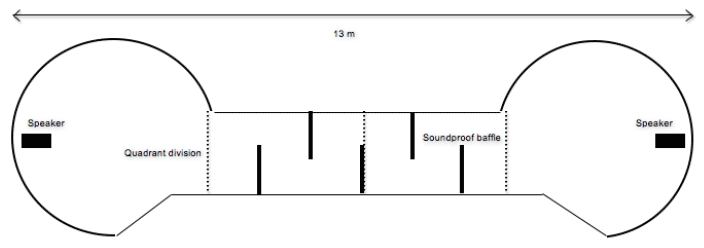
Physiological Experiment
As per previous studies, we used routine metabolic rate as an indicator of stress (Barton, 2002; Simpson et al., 2015) to investigate whether altered movement patters (behaviour) are a consequence of an altered physiological state. To assess active metabolic rate we determined the dissolved oxygen depletion for an individual fish over a two-hour trial duration. We subsequently calculated an individual's oxygen consumption rate relative to body mass in fish exposed to either pile driving noise, or an ambient control. The respirometry chamber was submerged within the annular tank. A Lubell LL916C underwater speaker, suspended from the gantry, was positioned 2 m from the chamber at a depth of 50 cm. The main tank room containing the annular tank (10 m diameter; total depth 1.06 m) was lit with white lights that were switched on between the hours of 08:00 and 17:00 each day. The respirometry system was tested over a two hour preliminary trial without a fish present to assess the effectiveness of the system and determine the influence of any microbial activity on our recorded dissolved oxygen levels (Figure 16 in supplementary information).
For each trial, a test salmon was transferred into the respirometry chamber between 15:00-17:00 the day before the trial was due to begin. Mesh was then cable-tied on to the top of the chamber to contain the fish during the overnight acclimation period. An Eheim universal pump (2014 EHEIM GmbH & Co. KG) was left running to help maintain a constant supply of oxygenated water. Following the acclimation period, the mesh was removed and the chamber lid bolted down. During this time, the Eheim pump continued to circulate oxygenated water from the annular tank into the chamber. An HD megapixel camera mounted on a Start 75 tripod was permanently attached to the lid to maintain the same camera position for each trial. The video recorder was started once the lid was secure. After 2 minutes, the pump inlet hose was connected to the chamber outlet to close the system. When the system was closed, water from the chamber was circulated through a watertight container, with a dissolved oxygen probe attached (Handheld dissolved oxygen meter - HI-9146N, Hanna Instruments Ltd.), and back into the test chamber. This provided a constant flow of water through the system and ensured that the water within the chamber was well mixed, thus preventing bias in the oxygen measurements resulting from localised depletions of dissolved oxygen. After a further two minutes, the exposure playback track (pile driving or ambient) was initiated. This point represented time zero of data collection.
In order to determine overall dissolved oxygen usage during the trial, dissolved oxygen concentration (ppm), oxygen saturation (%), and temperature of the water was recorded every 150 seconds. On completion of the trial the video recording was stopped and the Eheim pump disconnected, to pump in oxygenated water from the annular tank. The chamber lid was subsequently removed and the fish taken out. The fish was terminated using a Home Office Schedule 1 method (fatal blow to the head) before being weighed and measured.
The video was recorded directly onto a Panasonic DMR-EX86 DVD recorder during the trial before being backed up onto DVD for archiving and data analysis. During the trial, if the dissolved oxygen concentration dropped below a cut off limit of 6 mg/L the trial was stopped and the fish removed. Throughout the trials the limit of 6mg/l was never reached. The video of each trial was used to record the activity level of each fish. The overall time the fish spent moving around the tank was used to calculate a percentage activity level.
The initial and final dissolved oxygen concentrations from each trial were used to determine the oxygen consumption rate for each fish. The total volume of the respirometry system was 303 litres. Dissolved oxygen consumption rate was calculated by converting the change in oxygen (ppm) over the duration of the trial into micromoles of oxygen used per gram of tissue per hour (µmoles/g/h). A seawater salinity of 35 (g/l), along with the known average temperature for each trial, was used to calculate water density. A specific density per trial in g/cm 3 was then used to determine accurate concentrations of dissolved oxygen. These were applied to each trial to report the total dissolved oxygen consumed relative to the mass of each fish per hour. Oxygen consumption rate for each fish was plotted against its corresponding activity assessment. The gradient of the subsequent slope was then multiplied with the activity of the trial. The resultant values, representing an estimated oxygen consumption rate when the fish was active, were subtracted from the original consumption rates. This produced dissolved oxygen consumption rates factoring in variances in activity level between trials. Mean activity levels were calculated for both treatments to monitor for bias.
Statistical Analysis
All statistical analysis was carried out in R (Version 3.2.2). Dependent upon assumptions, either a two samples t-test or Wilcoxon rank sum test was used to analyse the behavioural experiment and mean relative oxygen consumptions/activity levels. A Linear Regression model was used for the analysis of relative oxygen consumption and activity level.
Results
Behavioural Experiment
Fish in the control treatment spent significantly more time at either end of the dumbbell tank during the 4-hour exposure compared with fish in the pile-driving treatment ( Figure 12). Capturing combined fish positions every minute showed that control fish spent an average of 45.00% of the exposure period in the near pod, compared to 34.06% for fish played pile driving (Wilcoxon rank sum test (W: 23.5; p-value: 0.049). In addition, the control fish spent 44.58% of the trial duration at the far end pod, whereas the fish in the piling treatment spent an average of 32.83% (Wilcoxon rank sum test (W: 18; p-value: 0.017). However, there was no statistical difference in time spent at the near end pod between the pre-exposure ambient hour and first hour of the experimental sound treatment. In the ambient treatment the average change in percentage time spent at the near end pod was -3.33%, whereas in the pile driving treatment it was 5.67% ( Figure 13; two-sample t-test (t: 1.664; df: 18; P-value: 0.113).
Figure 12: A; Proportion of time both fish spent in the near end pod (pod with speaker playing pile driving) over the four hour exposure period (Wilcoxon rank sum test (W: 23.5; p-value: 0.049). Near end pod in the ambient trials was defined using the respective piling trial in the block of two. B; Proportion of time both fish spent in the far end pod (pod furthest from the speaker playing pile driving) over the four hour exposure period (Wilcoxon rank sum test (W: 18; p-value: 0.017). Control: weight 3578.58 g ± 206.38 (mean ± SE); TL 677.25 mm ± 12.14; N = 10. Pile Driving: weight 3611.63 g ± 227.63, TL 678.00 mm ± 13.70; N = 10.
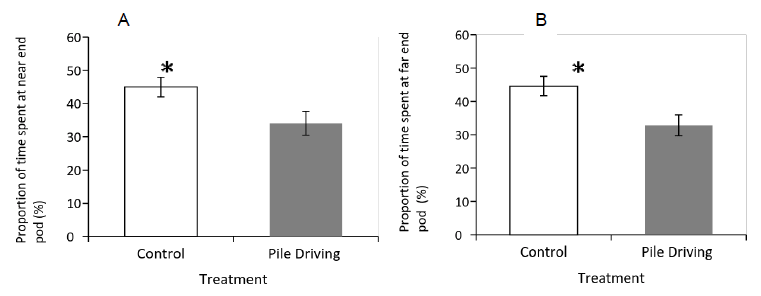
Figure 13: Average percentage change between the pre-exposure hour and first exposure hour in the proportion of time fish spent at the near end speaker. Control: weight 3578.58 g ± 206.38 (mean ± SE); TL 677.25 mm ± 12.14; N = 10. Pile Driving: weight 3611.63 g ± 227.63, TL 678.00 mm ± 13.70; N = 10. Two-sample t-test (t: 1.664; df: 18; P-value: 0.113).
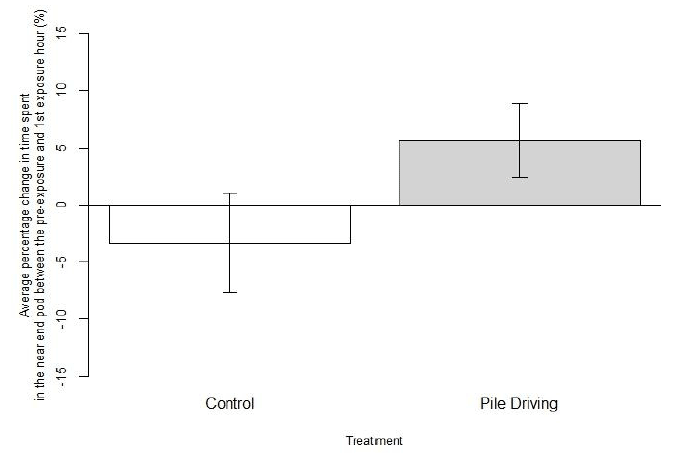
Physiological Experiment
Activity level was shown to be a strong predictor of oxygen consumption rate for individual fish (Regression analysis; R 2=0.549, F (1,21)=25.55, p-value= <0.005, N=23, Figure 14A). The resultant linear model was used to factor out activity from the oxygen consumption rates. In both treatments, activity level was a strong predictor of dissolved oxygen consumption (Ambient; Regression analysis: R 2: 0.664; F=17.76 (1,9), p-value= 0.0023; N=11; Pile driving; Regression analysis: R 2=0.470, F=8.86 (1,10), p-value= 0.0139; N=12; Fig. 14B). Fish exposed to pile driving noise had no statistical difference in oxygen consumption rate compared to the control treatment (two sampled t.test: t= 0.62, df=21, N=23, p-value=0.539; Figure 15). There was no statistical difference in mean activity level between treatment groups (Wilcoxon rank sum test: W = 59, N=23, p-value=0.695). Three trials were dropped from the analysis due to a lack of fish activity data, two from the ambient exposure group and one from the pile driving treatment. Figure 16 (supplementary information) displays the dissolved oxygen concentration and saturation recorded in the respirometry chamber over a 2 hour duration without a fish present.
Figure 14: A; Dissolved oxygen consumption rate (µmoles/g/hr) against activity level (duration of trial spent moving~ percentage time over trial duration). Weight 1319.48 g ± 62.82 (mean ± SE); TL 480.17 mm ± 5.37; Regression analysis; R 2=0.549, F (1,21)=25.55, p-value= <0.005, N=23. B; Dissolved oxygen consumption rate (µmoles/g/hr) against activity level (duration of trial spent moving ~ percentage time over trial duration) of both treatment groups (Ambient control, Pile Driving). Ambient: Weight 1329.97 g ± 97.66; TL 485.73 mm ± 7.33; N = 11; Regression analysis: R 2: 0.664; F (1,9)=17.76, p-value= 0.0023. Pile driving: Weight 1309.86 g ± 84.63; TL 475.08 mm ± 7.81; N = 12; Regression analysis: R 2=0.470, F=8.86 (1,10), p-value= 0.0139).
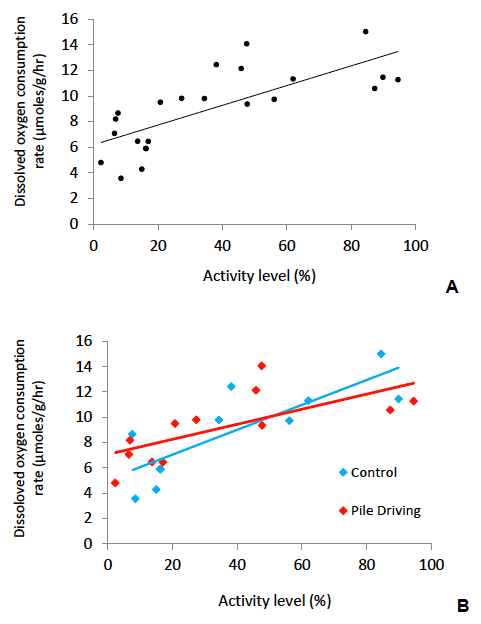
Figure 15: Average oxygen consumption rate relative to body mass of marine phase Atlantic salmon ( Salmo salar) exposed to pile driving noise against an ambient control, with activity factored in. Ambient: 5.91 µmoles/g -1/hr -1 ± 0.66 (mean ± SE); Weight 1329.97 g ± 97.66; TL 485.73 mm ± 7.33; Activity level 38.97 % ± 9.06; N = 11). Pile driving: 6.46 µmoles/g -1/hr -1 ± 0.58); Weight 1309.86 g ± 84.63; TL 475.08 mm ± 7.81; Activity level 34.80 % ± 8.89; N = 12). Two sampled t.test: t= 0.62, df=21, N=23, p-value=0.539.
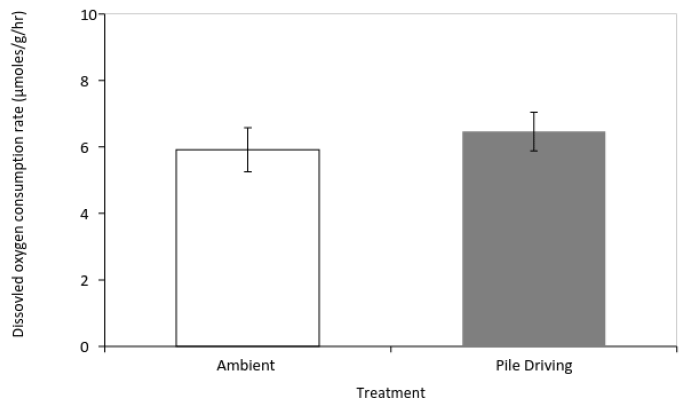
Discussion
In the behavioural experiment we found salmon in the ambient control treatment spent significantly more time at either end pod of the dumbbell tank compared to the piling treatment. However, despite the observation we found no difference between the proportion of time spent at the near end pod during the pre-exposure hour and the first exposure hour. The behaviour observed in the pre-exposure hour tended to match the movement captured in the rest of the trial. This strongly suggests that the additional noise of the piling is not driving the observed differences in behaviour between the two treatments. Additionally, there was no clear evidence of a startle response in relation to playback of individual hammer strikes (H Harding pers. obs.). In a previous study, although using a different noise stimulus, juvenile Atlantic salmon failed to display avoidance behaviours in response to a 150 Hz sound, 30 dB above defined awareness reaction thresholds (Knudsen et al., 1992). Similarly, juvenile coho salmon displayed no avoidance behaviour from exposure to a real impact-piling event when positioned in cages close to the noise source (Ruggerone et al., 2008).
The physiological experiment has shown marine-phase Atlantic salmon do not experience a change in active metabolic rate ( AMR), using oxygen consumption as a proxy, when exposed to pile driving noise ( Figure 15). Using an alteration in AMR as an indicator of stress, this would suggest the cohort of Atlantic salmon used here did not perceive the pile driving playback noise as a stressor. In contrast, other anthropogenic noise stimuli, such as ship noise, have been shown to be a stressor in a number of other species (Wysocki et al., 2006; Slabbekoorn et al., 2010), which can lead to alterations in metabolic scope and subsequent consequences on predator avoidance and immune system functioning (Barton, 2002, Simpson et al., 2015). One explanation for this may centre on Atlantic salmon hearing ability. Compared to other teleost fish, including Atlantic cod ( Gadus morhua) and herring ( Clupea harengus), Atlantic salmon are particularly sound insensitive lacking specialist hearing mechanisms (Chapman & Hawkins, 1973; Hawkins & Johnstone 1978). The lack of such mechanisms reduces the fish's sensitivity and bandwidth to detect a noise stimulus, resulting in a poorer ability to distinguish specific acoustic cues from background noise (Hawkins & Johnstone, 1978; Popper & Fay, 1993; Kenyon et al., 1998; Radford et al., 2012). The nature of salmon hearing would, therefore, suggest a subdued or lack of response to specific noise stimuli and is consistent to the data we present here. In a closely related species, the brown trout ( Salmo trutta), no observable changes in behaviour were recorded from exposure to a real piling event (average noise level 134 re 1 µPa, peak), supporting responses seen in our study (Nedwell et al., 2003).
The lack of significant response seen in the respirometry experiment is not attributed to poor functioning of the chamber. The effectiveness of the respirometry equipment, system and validation of the oxygen consumption data is provided by the recorded activity level being a strong predictor of oxygen consumption rate (Figure 14A). Due to the size of the respirometry chamber, the individual fish was allowed to move in the arena during the trial. This posed a potential problem of varying activity levels influencing the calculated oxygen consumption rate. Despite this, activity was balanced between treatments, suggesting that activity level was not related to the sound stimulus presented (Figure 14B). The barrier of the respirometry chamber wall was not shown to have reduced the particle motion component of the sound field (Figure10). We recorded particle acceleration levels (Channel XY) of 107.15 (dB re (1µm/s^2) inside the chamber compared to 106.79 (dB re (1µm/s^2) outside.
The suite of different experimental measures used in this study enabled us to assess organism effects upon multiple levels. If a fish perceives a stimulus as a stressor then a number of physiological response mechanisms are triggered; if the physiological responses become maladaptive, then to maintain 'normal' functioning, changes in behaviour will occur with the aim to reduce exposure to the stressor ( Schreck et al., 1997; Barton, 2002). We used active metabolic rate to determine whether altered movement patterns are a potential consequence of an altered physiological state (Barton, 2002; Simpson et al., 2015). The absence of a stress response from exposure to piling playback, therefore, compares well with there being no change in movement behaviour (avoidance response).
In this study we fully characterised both elements of the sound field (pressure and particle motion) for each experiment. This provided unique data on fish responses to defined particle motion values; such data are not often included when investigating the effects of anthropogenic noise on marine organisms. Despite continued developments to characterise particle motion in the field, recordings from a range of noise sources under varying environmental conditions are still required (Merchant et al., 2015). In light of this, we are not able to make direct comparisons of our recorded levels of particle motion to real noise sources.
Using captive fish in tank-based experiments provided the opportunity to minimise confounding variables and collect accurate data, free from a complex mix of variables present in fieldwork (Halvorsen et al., 2012; Simpson et al., 2015). However, another possible explanation for the lack of either a behavioural or physiological response may be due to the environmental conditions the fish were raised. The present study used marine-phase Atlantic salmon with all cohorts of fish tested kept in captivity since hatching or brought to the aquarium as smolt. The acoustic history of the fish may have contributed to the biological responses observed. Studies have shown temporary changes in hearing thresholds, for a range of species with varying hearing abilities, from exposure to increased continuous noise levels (Smith et al., 2004; Wysocki & Ladich 2004, Halvorsen et al., 2009 ). Conversely, exposure to a continuous 150 dB re 1µPa RMS ambient noise for eight months produced no changes in hearing sensitivity in rainbow trout ( Oncorhynchus mykiss) (Wysocki et al., 2007). There is currently a paucity of data on whether noise from hatchery systems can cause permanent changes in hearing thresholds in captive reared Atlantic salmon. Further research is needed to identify how hearing sensitivities of such fish compare to wild conspecifics of the same development stage. This will aid in determining how useful captive fish are as a model for wild Atlantic salmon responses to an acoustic disturbance. The use of captive reared salmon in this study means we are unable to extrapolate our results to wild populations.
In tank-based studies it is not possible to fully replicate a natural sound field due to reflections and reverberations around the aquaria (Okumura et al., 2002). The playback of pile driving we presented shared similar acoustic characteristics to the real stimuli, including rapid rise times and maximum pressure levels below 1kHz (Normandeau Associates, 2012; Radford et al., 2014). The design of the experiment enabled any differences observed during the trials to be attributed to the additional noise of the pile driving. Therefore, these experiments provided an initial assessment for the potential impact of pile driving playback on captive reared Atlantic salmon.
Further research is required to determine both the influence of pile driving on wild fish and a comparative analysis of the responses of other species to the same sound stimulus. It is very difficult to extrapolate behavioural responses, such as movement, from fish held in small arenas (Popper & Hastings, 2009). This study made use of the large dumbbell tank at the Marine Laboratory to provide a large arena to infer behavioural responses to pile driving. However, in order to provide meaningful, robust data for marine regulators biological response measures are needed from exposures to a real noise source in an open soundscape. This study represents a key stepping stone towards such field-based experiments.
Acknowledgments
We are grateful to Ben Williamson and his team (Mark Paterson and Louise Feehan) for their support and assistance in experimental setup and running of procedures. We thank Helen Drewery, Kate Brookes and David Bruno for advice and logistical support, to Defra (Contract ME5207) for funding the electrophysiology system and to Dennis Higgs for training in AEP audiometry.
References
Bailey H, Senior B, Simmons D, Rusin J, Picken G, Thompson PM (2010) Assessing underwater noise levels during pile-driving at an offshore windfarm and its potential effects on marine mammals. Marine Pollution Bulletin, 60, 888-897.
Barton BA (2002) Stress in Fishes: A diversity of responses with particular reference to changes in circulating corticosteroid. Integrative and comparative biology, 42, 517-525.
Brittan-Powell EF, Dooling RJ, Gleich O (2002) Auditory brainstem responses in adult budgerigars ( Melopsittacus undulatus). Journal of the Acoustical Society of America 112:999-1008
Bruintjes R & Radford AN (2014) Chronic playback of boat noise does not impact hatching success or post-hatching larval growth and survival in cichlid fish. PeerJ 2:e594, https://doi.org/10.7717/peerj.594.
Chapman CJ & Hawkins AD (1973) A field study of hearing in the cod, Gadus morhua L. Journal of comparative physiology, 85, 147-167.
Corwin JT, Bullock TH, Schweitzer J (1982) The auditory brainstem response in five vertebrate classes. Electroencephalography and Clinical Neurophysiology 54:629-641
Hall JW (1992) Handbook of auditory evoked responses. Allyn and Bacon, Boston
Halvorsen MB, Wysocki LE, Stehr CM, Baldwin DH, Chicoine DR, Scholz NL, Popper AN (2009) Barging effects on sensory systems of Chinook salmon smolts. Transactions of the American Fisheries Society, 138, 777-789.
Halvorsen MB, Casper BM, Woodley CM, Carlson TJ, Popper AN (2012) Threshold for onset of injury in Chinook salmon from exposure to impulsive pile driving sounds. PLoS ONE, 7(6), 1-11.
Hawkins AD, Pembroke AR, Popper AN (2015) Information gaps in understanding the effects of noise on fishes and invertebrates. Reviews in Fish Biology Fisheries, 25, 39-64.
Hawkins AD & Johnstone ADF (1978) The hearing of the Atlantic salmon, Salmo salar. Journal of fish biology, 13 , 655-673.
Hildebrand JA (2009) Anthropogenic and natural sources of ambient noise in the ocean. Marine Ecology Progress Series, 395, 4-20.
Hildebrand JA (2005) Impacts of Anthropogenic Sound. Marine Mammal Research: conservation beyond crisis (eds Reynolds JE, Perrin WF, Reeves RR, Montgomery S, Ragen TJ), 101-124. The Johns Hopkins University Press, Baltimore, Maryland.
Kenyon TN, Ladich F, Yan HY (1998) A comparative study of hearing ability in fishes: the auditory brainstem response approach. Journal of comparative physiology A, 182, 307-318.
Knudsen FR, Enger PS, Sand O (1992) Awareness reactions and avoidance responses to sound in juvenile Atlantic salmon, Salmo salar. Journal of fish biology, 40, 523-534.
Mann D, Higgs D, Tavolga W, Souza M, Popper AN (2001) Ultrasound detection by clupeiform fishes. Journal of the Acoustical Society of America 109:3048-3054
McDonald MA, Hildebrand JA, Wiggins SM (2006) Increases in deep ocean ambient noise in the Northeast Pacific west of San Nicholas Island, California. Journal of the Acoustical Society of America, 120, 711-718.
Merchant ND, Fristrup KM, Johnson MP, Tyack PL, Witt MJ, Blondel P, Parks SE (2015) Measuring acoustic habitats. Methods in Ecology and Evolution, 6, 257-265.
Nedwell J, Turnpenny A, Langworthy J, Edwards B (2003) Measurements of underwater noise during piling at the Red Funnel Terminal, Southampton, and observations of its effect on caged fish. Subacoustech Ltd. Document reference: 558 R 0207.
Nedwell JR, Edwards B, Turnpenny AWH, Gordon J (2004) Fish and marine mammal audiograms:
A summary of available information. Report Reference: 534R0214, Subacoustech Ltd, Hampshire UK
Nedwell JR & Mason TI (2012) Modelling of noise during impact piling operations at the Neart na Gaoithe Offshore wind farm in the Firth of Forth. Subacoustech Environmental Ltd. Subacoustech Environmental report No. E297R0106.
Normandeau Associates, Inc. (2012) Effects of noise on fish, fisheries, and invertebrates in the U.S. Atlantic and Arctic from energy industry sound-generating activities. A literature synthesis for the U.S. Dept. of the Interior, Bureau of Ocean Energy Management. Contract # M11PC00031, 1-361 pp. Available at: http://www. data.boem.gov/homepg/data_center/other/espis/espismaster.asp?appid=1 (accessed 14 December 2015).
Okumura T, Akamatsu T, Yan, HY (2002) Analyses of small tank acoustics: Empirical and theoretical approaches. Bioacoustics: the international journal of animal sound and its recording, 12(2-3), 330-332.
Popper AN & Fay RR (1993) Sound detection and processing by fish: critical review and major research questions. Brain, Behaviour and Evolution, 41, 14-38.
Popper AN, Halvorsen MB, Kane AE, Miller DL, Smith ME, Stein P, Wysocki LE (2007) The effects of high-intensity, low-frequency active sonar on rainbow trout. Journal of the Acoustical Society of America 122:623-635
Popper AN, Hastings MC (2009) The effects of anthropogenic sources of sound on fishes. Journal of Fish Biology, 75, 455-489.
Purser J & Radford AN (2011) Acoustic noise induces attention shifts and reduces foraging performance in Three-Spined Sticklebacks ( Gasterosteus aculeatus). PLoS ONE, 6(2), 1-8.
Radford CA, Montgomery JC, Caiger P, Higgs DM (2012) Pressure and particle motion detection thresholds in fish: a re-examination of salient auditory cues in teleosts. The journal of experimental biology, 215, 3429-3435.
Radford AN, Kerridge E, Simpson SD (2014) Acoustic communication in a noisy world: can fish compete with anthropogenic noise? Behavioural Ecology, 00(00), 1-9.
Ruggerone GT, Goodman S, Miner R (2008) Behavioural Responses and Survival of Juvenile Coho Salmon Exposed to Pile Driving Sounds. Natural Resources Consultants, Inc. 1-42 pp. Available at: http://home.comcast.net/~ruggerone/FishTerminalPileDriveStudy.pdf (accessed 04 February 2016).
Schreck CB, Olla BL, Davis MW (1997) Behavioural responses to stress. In: Fish stress and health in aquaculture. Society for experimental biology seminar series (eds Iwama GK, Pickering AD, Sumpter JP, Schreck CB), 62, 145- 170. Cambridge University Press, Cambridge, UK.
Simpson SD, Purser J, Radford AN (2015) Anthropogenic noise compromises antipredator behaviour in European eels. Global Change Biology. Doi: 10.1111/gcb.12685.
Slabbekoorn H, Bouton N, van Opzeeland I, Coers A, ten Cate C, Popper AN (2010) A noisy spring: the impact of globally rising underwater sound levels on fish. Trends in Ecology and Evolution, 25(7), 419-427.
Smith ME, Kane, AS, Popper AN (2004) Noise-induced stress and hearing loss in goldfish ( Carassius auratus). The journal of Experimental Biology, 207, 427-435.
Tyack P (2008) Implications for marine mammals of large-scale changes in the marine acoustic environment. Journal of Mammalogy, 89, 549-558.
Wale MA, Simpson SD, Radford AN (2013) Noise negatively affects foraging and antipredator behaviour in shore crabs. Animal behaviour, 86, 111-118.
Wysocki LE, Davidson III JW, Smith ME, Frankel AS, Ellison WT, Mazik PM, Popper AN, Bebak J (2007) Effects of aquaculture production noise on hearing, growth, and disease resistance of rainbow trout Oncorhynchus mykiss. Aquaculture, 272, 687-697.
Wysocki LE, Dittami JP, Ladich F (2006) Ship noise and cortisol secretion in European freshwater fishes. Biological conservation, 128, 501-508.
Wysocki LE & Ladich F (2004) Hearing in Fishes under Noise Conditions. Journal of the association for research Otolaryngology, 6, 28-36.
Figure 3: Power spectral densities of pile driving and ambient playback (both J9 sound projectors), background noise of the dumbbell tank and fish holding tank. The hydrophone was positioned 15 cm from the speaker. Fast Fourier Transform (FFT) analysis of sound recordings, using SASLab Pro v4.5.2 (Avisoft Bioacoustics, Berlin), power spectral analysis (level units, averaged), Hamming evaluation window, FFT size 1024, 43 Hz resolution), recordings averaged from 12 s samples, piling track: 10 hammer strikes, 1.2 seconds for each strike. The background holding tank recording was made with the hydrophone positioned off the bottom of the tank.
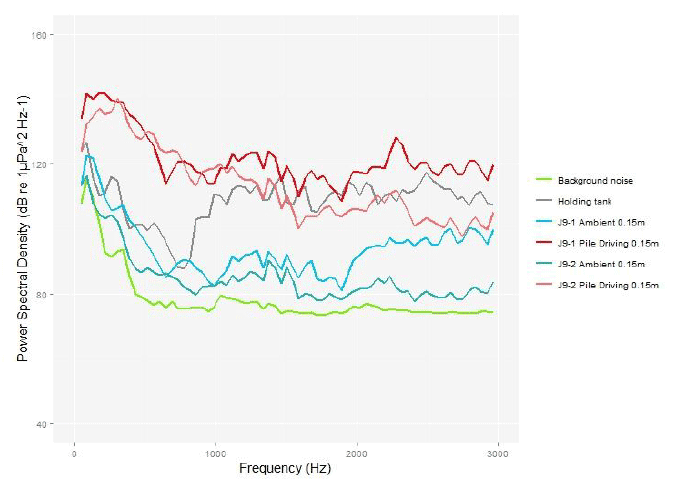
Figure 4: Power spectral densities of pile driving playback from one of the J9 sound projectors (J9-1). The hydrophone was positioned at various intervals from the speaker (0.15, 3, 5, 7, 9, 10, 13m). Fast Fourier Transform (FFT) analysis of sound recordings, using SASLab Pro v4.5.2 (Avisoft Bioacoustics, Berlin), power spectral analysis (level units, averaged), Hamming evaluation window, FFT size 1024, 43 Hz resolution), recordings averaged from 12 second samples, 10 hammer strikes, 1.2 seconds for each strike.
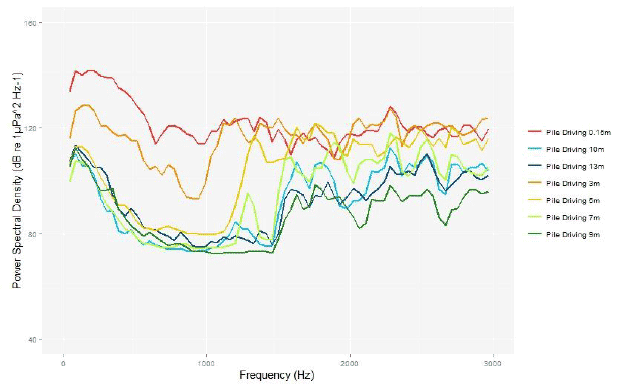
Figure 5: Power spectral densities of pile driving playback from one of the J9 sound projectors (J9-2). The hydrophone was positioned at various intervals from the speaker (0.15, 3, 5, 7, 9, 13m). Fast Fourier Transform (FFT) analysis of sound recordings, using SASLab Pro v4.5.2 (Avisoft Bioacoustics, Berlin), power spectral analysis (level units, averaged), Hamming evaluation window, FFT size 1024, 43 Hz resolution), recordings averaged from 12 s samples, 10 hammer strikes, 1.2 seconds for each strike.
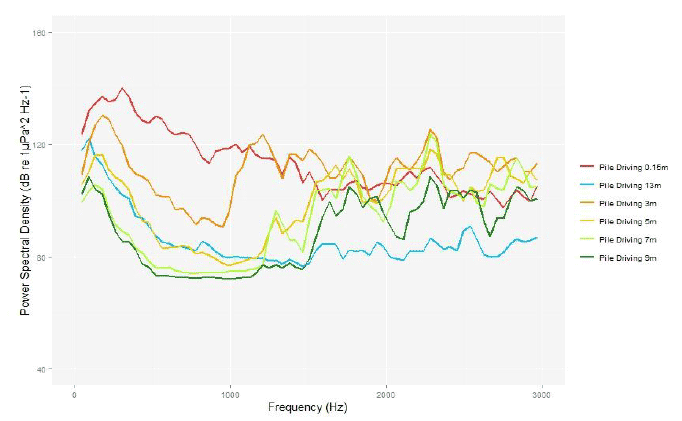
Figure 6: Power spectral densities of recordings made of both playback files (ambient and pile driving), background noise of the annular tank and tank two (holding tank) (averaged from 12 second recordings). The background holding tank recording was made with the hydrophone positioned off the bottom of the tank. All recordings were made using a Sony linear PCM recorder with an HTI hydrophone positioned within the respirometry chamber 20cm from the bottom. The chamber was positioned two meters from the speaker (Lubell LL916C). Fast Fourier Transform (FFT) analysis of sound recordings, using SASLab Pro v4.5.2 (Avisoft Bioacoustics, Berlin), power spectral analysis (level units, averaged), Hamming evaluation window, FFT size 1024, 43 Hz resolution, 12 second recording, piling track: 10 hammer strikes, 1.2 seconds for each strike).
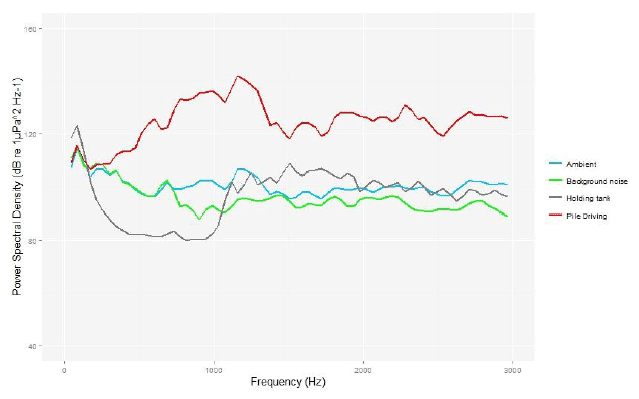
Figure 7: Power spectral densities (Channel XY) of ambient (0.1m) and pile driving (0.1m) playback in the dumbbell tank from both J9 sound projectors used in the experiment. Measured using a M30 calibrated accelerometer. Ambient measurements made from 12 s of ambient recording. Pile driving measurements made from 12 seconds of recording (10 hammer strikes, 1.2 seconds for each strike). Analysis performed using MatLab (R2013a; 8.1.0.604; MathWorks Inc. Sampling rate 44100Hz, Hamming window, Bandpass filter 0-3kHz).
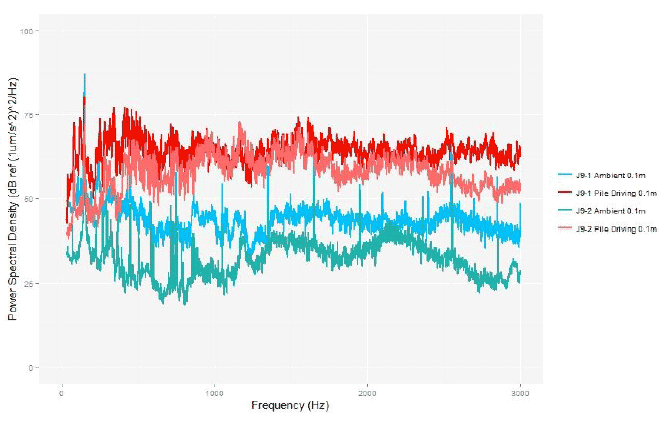
Figure 8: Power spectral densities (Channel XY) of pile driving playback measured at 0.1, 2.75, 4.75, 6.75, 8.75, 10.75, 12.75m along the dumbbell tank (J9-1). Measured using a M30 calibrated accelerometer. Ambient measurements made from 12 s of ambient recording. Pile driving measurements made from 12 seconds of recording (10 hammer strikes, 1.2 seconds for each strike). Analysis performed using MatLab (R2013a; 8.1.0.604; MathWorks Inc. Sampling rate 44100Hz, Hamming window, Bandpass filter 0-3kHz).
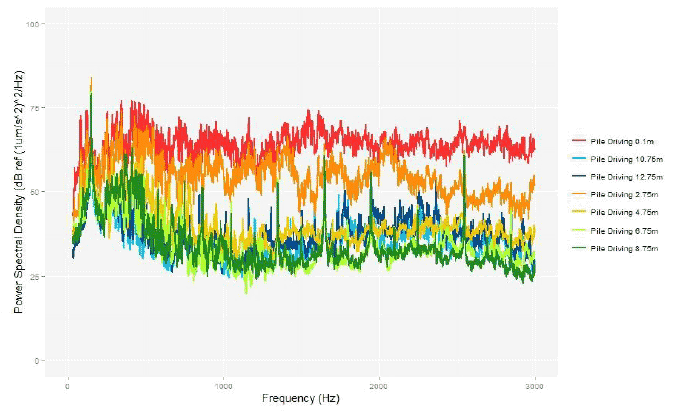
Figure 9: Power spectral densities (Channel XY) of pile driving playback measured at 0.1, 2.75, 4.75, 6.75, 8.75, 10.75, 12.75 m along the dumbbell tank (J9-2). Measured using a M30 calibrated accelerometer. Ambient measurements made from 12 s of ambient recording. Pile driving measurements made from 12 seconds of recording (10 hammer strikes, 1.2 seconds for each strike). Analysis performed using MatLab (R2013a; 8.1.0.604; MathWorks Inc. Sampling rate 44100Hz, Hamming window, Bandpass filter 0-3kHz).
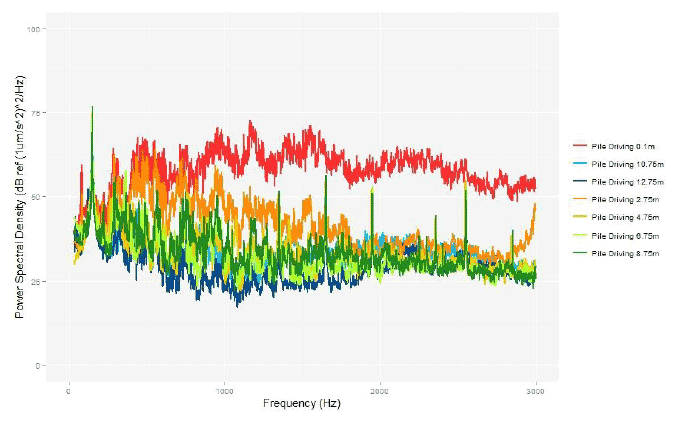
Figure 10: Power spectral density (Channel XY) of ambient and pile driving playback in the respirometry experiment. Measured using a M30 calibrated accelerometer positioned within the respirometry chamber 20 cm from the base of the tank (2.4 m from speaker) and next to the chamber 2 m from the Lubell LL916C loud speaker. The chamber was positioned two meters from the speaker (Lubell LL916C). Ambient measurements made from 10 s of ambient recording. Pile driving measurements made from 10 hammer strikes (10 s recording, 1 s from each strike). Analysis performed using MatLab (R2013a; 8.1.0.604; MathWorks Inc. Sampling rate 44100Hz, Hamming window, Bandpass filter 0-3kHz).
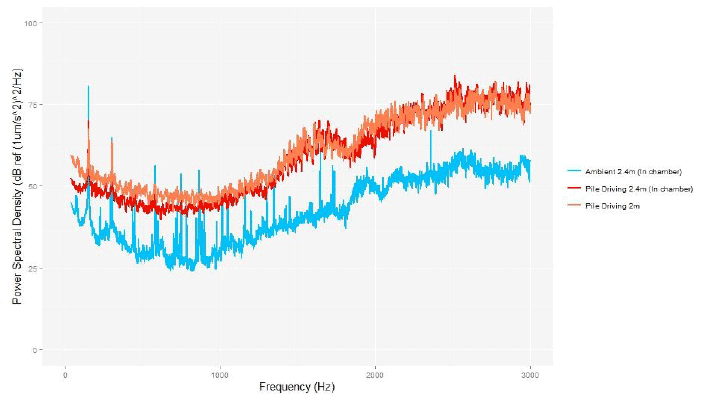
Images of the AEP set up in Operation
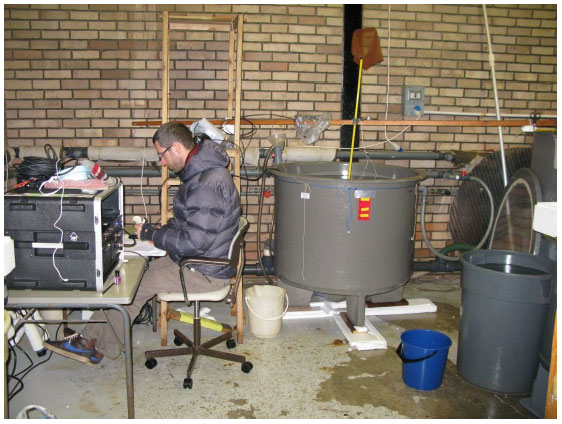
Above: Complete set up of the AEP equipment.
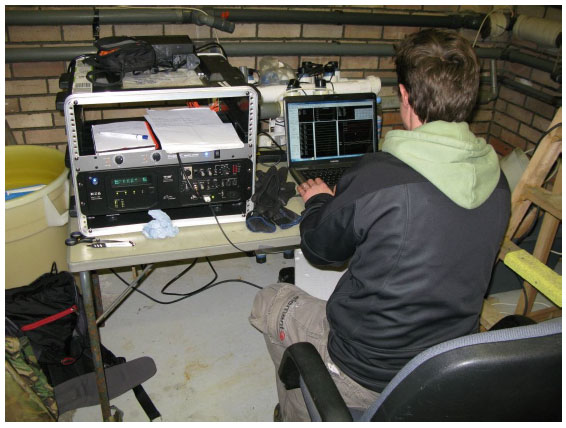
Above: Signal generation and data acquisition equipment.
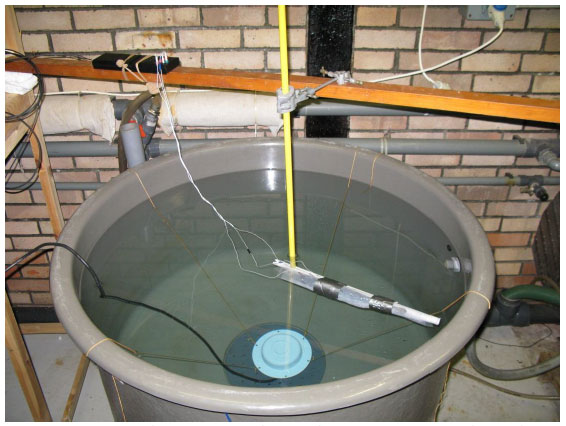
Above: 1 m diameter fibreglass tank with fish AEP apparatus set up.
Images of Behavioural Experiment
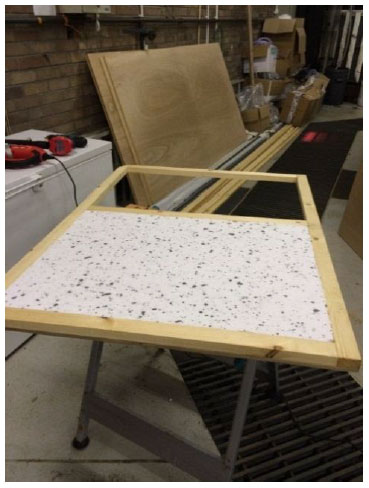
Above: Soundproof baffles under construction for the dumbbell tank.
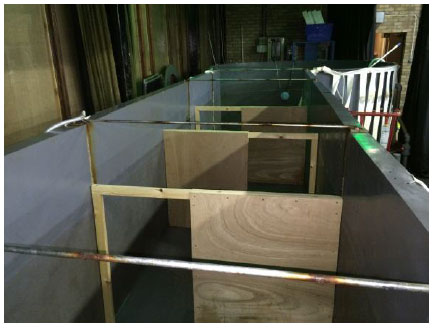
Above: Soundproof baffles installed in the dumbbell tank raceway prior to additional bubble wrap being added.
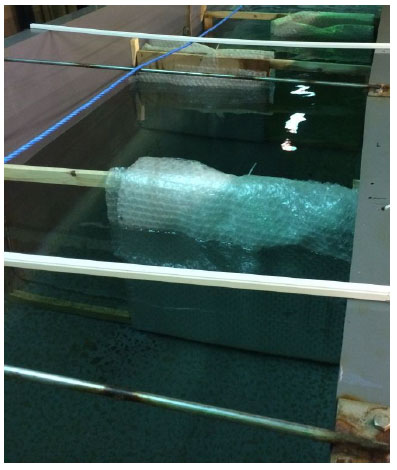
Above: Bubble wrap added to each of the baffles to aid in sound attenuation.
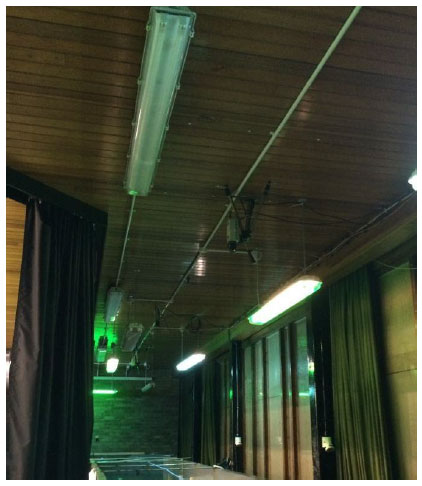
Above: Three CCTV video cameras attached to the ceiling above the dumbbell tank to record fish movement.
Images of Physiological Experiment
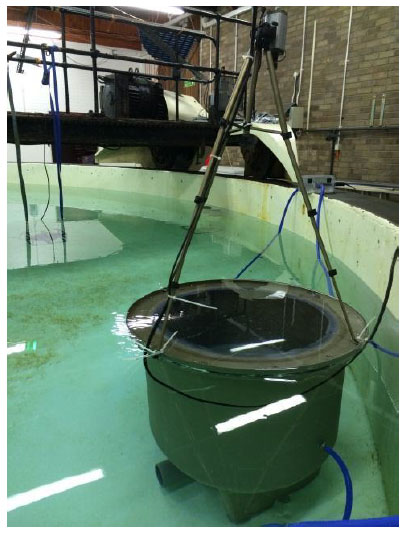
Above: Respirometer in the annular tank with the HD megapixel camera positioned above the chamber to film the fish.
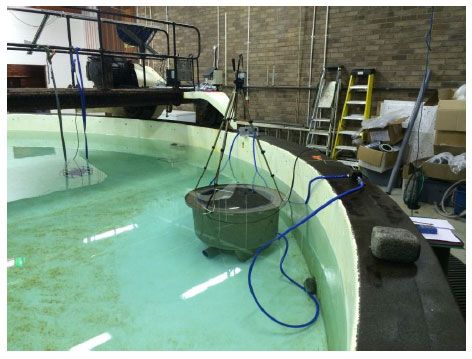
Above: Respirometer positioned in the annular tank 2 meters from the speaker, with the pumping system to circulate water in the chamber in place.
Supplementary Information
Figure 16: Dissolved oxygen concentration and oxygen saturation measured over two hours in the sealed respirometer without a fish present.
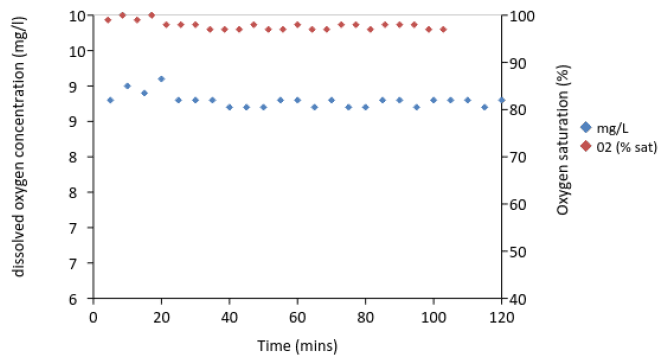
Contact
There is a problem
Thanks for your feedback